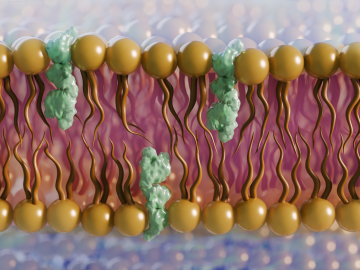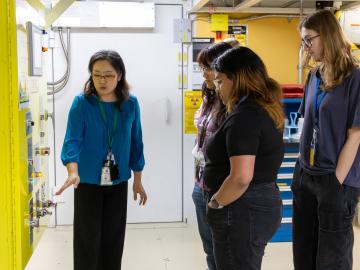
Filter News
Area of Research
- Advanced Manufacturing (2)
- Biological Systems (1)
- Biology and Environment (10)
- Computational Biology (1)
- Energy Science (4)
- Fusion and Fission (1)
- Isotopes (4)
- Materials (18)
- Materials for Computing (2)
- National Security (3)
- Neutron Science (54)
- Nuclear Science and Technology (2)
- Supercomputing (14)
News Type
News Topics
- (-) Biomedical (42)
- (-) Neutron Science (82)
- (-) Physics (34)
- 3-D Printing/Advanced Manufacturing (56)
- Advanced Reactors (12)
- Artificial Intelligence (77)
- Big Data (45)
- Bioenergy (68)
- Biology (80)
- Biotechnology (25)
- Buildings (30)
- Chemical Sciences (35)
- Clean Water (16)
- Composites (11)
- Computer Science (111)
- Coronavirus (19)
- Critical Materials (5)
- Cybersecurity (14)
- Education (2)
- Emergency (3)
- Energy Storage (32)
- Environment (116)
- Exascale Computing (51)
- Fossil Energy (6)
- Frontier (44)
- Fusion (38)
- Grid (32)
- High-Performance Computing (81)
- Hydropower (6)
- Isotopes (33)
- ITER (4)
- Machine Learning (37)
- Materials (51)
- Materials Science (55)
- Mathematics (8)
- Mercury (7)
- Microelectronics (3)
- Microscopy (23)
- Molten Salt (2)
- Nanotechnology (17)
- National Security (60)
- Nuclear Energy (66)
- Partnerships (36)
- Polymers (9)
- Quantum Computing (35)
- Quantum Science (48)
- Security (16)
- Simulation (42)
- Software (1)
- Space Exploration (13)
- Statistics (2)
- Summit (40)
- Transportation (30)
Media Contacts

Distinguished materials scientist Takeshi Egami has spent his career revealing the complex atomic structure of metallic glass and other liquids — sometimes sharing theories with initially resistant minds in the scientific community.
After retiring from Y-12, Scott Abston joined the Isotope Science and Engineering Directorate to support isotope production and work with his former manager. He now leads a team maintaining critical equipment for medical and space applications. Abston finds fulfillment in mentoring his team and is pleased with his decision to continue working.

Using LEGO® bricks, Robert Saethre has worked to create a model of the ring injection region of the SNS pulsed accelerator that features the new Proton Power Upgrade magnets and vacuum chambers.

A group of scientists at the Department of Energy’s Oak Ridge National Laboratory have conducted neutron scattering research to reveal key information about fungus cell membranes that could aid in developing new antifungal treatments.

Nuclear physicists at the Department of Energy’s Oak Ridge National Laboratory recently used Frontier, the world’s most powerful supercomputer, to calculate the magnetic properties of calcium-48’s atomic nucleus.

Jeremiah Sewell leads a team at ORNL, working on xenon-129 production for lung imaging. Reflecting on his career, Sewell views each opportunity as a "door" he steps through, leveraging over 25 years of experience in nuclear power and centrifuge operations to advance the facility’s mission.

At ORNL, a group of scientists used neutron scattering techniques to investigate a relatively new functional material called a Weyl semimetal. These Weyl fermions move very quickly in a material and can carry electrical charge at room temperature. Scientists think that Weyl semimetals, if used in future electronics, could allow electricity to flow more efficiently and enable more energy-efficient computers and other electronic devices.

The 26th annual National School on Neutron and X-ray Scattering School concluded on August 9, 2024. Each year, more than 200 graduate students in North America studying physics, chemistry, engineering, biological matter and more compete to participate in NXS. However, given limited space, only 60 can be accepted. The school exposes graduate students to neutron and X-ray scattering techniques through lectures, experiments, and tutorials.

Scientists have determined that a rare element found in some of the oldest solids in the solar system, such as meteorites, and previously thought to have been forged in supernova explosions, actually predate such cosmic events, challenging long-held theories about its origin.

Brian Sanders is focused on impactful, multidisciplinary science at Oak Ridge National Laboratory, developing solutions for everything from improved imaging of plant-microbe interactions that influence ecosystem health to advancing new treatments for cancer and viral infections.


